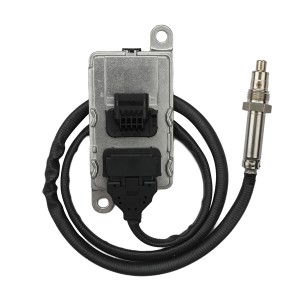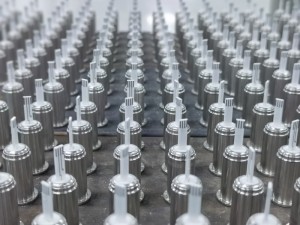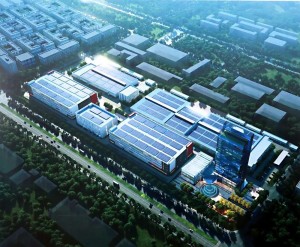A nitrogen oxygen sensor (NOx sensor) is a sensor used to detect the content of nitrogen oxides (NOx) such as N2O, no, NO2, N2O3, N2O4 and N2O5 in engine exhaust. According to the working principle, it can be divided into electrochemical, optical and other NOx sensors. Using the conductivity of solid electrolyte yttrium oxide doped zirconia (YSZ) ceramic material to oxygen ions, the selective catalytic sensitivity of special NOx sensitive electrode material to NOx gas, and combining with special sensor structure to obtain the electrical signal of NOx, finally, using special weak signal detection and precision electronic control technology, the NOx gas in automobile exhaust is detected and converted into standard CAN bus digital signals.
Function of nitrogen oxygen sensor
- NOx measurement range: 0-1500 / 2000 / 3000ppm NOx
- O2 measurement range: 0 – 21%
- Maximum exhaust gas temperature: 800 ℃
- can be used under O2 (21%), HC, Co, H2O (< 12%)
- communication interface: can
Application field of NOx sensor
- diesel engine exhaust emission SCR system (meeting National IV, V and VI emission standards)
- gasoline engine exhaust gas treatment system
- desulfurization and denitration detection and control system of power plant
Composition of nitrogen oxygen sensor
The main core components of NOx sensor are ceramic sensitive components and SCU components
Core of NOx sensor
Because of the special use environment of the product, the ceramic chip is developed with an electrochemical structure. The structure is complex, but the output signal is stable, the response speed is fast, and the service life is long. The product meets the monitoring of NOx emission content in the process of diesel vehicle exhaust emission. The ceramic sensitive parts contain multiple ceramic internal cavities, involving zirconia, alumina and a variety of Pt series metal conductive pastes. The production process is complex, the screen printing accuracy is required, and the matching requirements of material formula / stability and sintering process are required
At present, there are three common NOx sensors on the market: flat five pin, flat four pin and square four pin
NOx sensor can communication
The NOx sensor communicates with ECU or DCU through can communication. The NOx assembly is internally integrated with a self diagnosis system (the nitrogen and oxygen sensor can complete this step by itself without requiring ECU or DCU to calculate the nitrogen and oxygen concentration). It monitors its own working state and feeds back the NOx concentration signal to ECU or DCU through the body communication bus.
Precautions for installation of NOx sensor
The NOx sensor probe shall be installed on the upper half of the catalyst of the exhaust pipe, and the sensor probe shall not be located at the lowest position of the catalyst. Prevent the nitrogen oxygen probe from cracking when encountering water. Installation direction of nitrogen oxygen sensor control unit: install the control unit vertically to better prevent it. Temperature requirements of NOx sensor control unit: the nitrogen and oxygen sensor shall not be installed in places with excessively high temperature. It is recommended to keep away from the exhaust pipe and near the urea tank. If the oxygen sensor must be installed near the exhaust pipe and the urea tank due to the layout of the whole vehicle, the heat shield and heat insulation cotton must be installed, and the temperature around the installation position must be evaluated. The best working temperature is not higher than 85 ℃.
Dew point protection function: because the electrode of the NOx sensor needs a higher temperature to work, the NOx sensor has a ceramic structure inside. Ceramics can't touch water at high temperature, and it is easy to expand and contract when it meets water, resulting in ceramic cracking. Therefore, the NOx sensor will be equipped with a dew point protection function, which is to wait for a period of time after detecting that the temperature of the exhaust pipe reaches the set value. ECU or DCU thinks that under such a high temperature, even if there is water on the NOx sensor, it will be blown dry by the high-temperature exhaust gas
Detection and diagnosis of NOx sensor
When the NOx sensor works normally, it detects the NOx value in the exhaust pipe in real time and feeds it back to ECU / DCU through CAN bus. ECU does not judge whether the exhaust is qualified by detecting the real-time NOx value, but detects whether the NOx value in the exhaust pipe exceeds the standard through a set of NOx monitoring program. To run NOx detection, the following conditions must be met:
The cooling water system works normally without fault codes. There is no fault code for the ambient pressure sensor.
The water temperature is above 70 ℃. A complete NOx detection requires about 20 samples. After one NOx detection, ECU / DCU will compare the sampled data: if the average value of all sampled NOx values is less than the set value during the detection, the detection passes. If the average value of all sampled NOx values is greater than the set value during detection, the monitor will record an error. However, the mil lamp is not turned on. If the monitoring fails for two consecutive times, the system will report Super 5 and super 7 fault codes, and the mil lamp will turn on.
When the 5 fault code is exceeded, the mil lamp will be on, but the torque will not be limited. When the 7 fault code is exceeded, the mil lamp will be turned on and the system will limit the torque. The torque limit is set by the model manufacturer.
Note: even if the emission overrun fault of some models is repaired, the mil lamp will not go out, and the fault status will be displayed as a historical fault. In this case, it is necessary to brush the data or perform the high NOx reset function.
Relying on the group company's 22 years of industry experience and strong software R & D capability, Yunyi Electric has made use of the domestic top expert team and integrated the resources of three R & D bases around the world to achieve major innovation in NOx sensor control software algorithm and product calibration matching, and solved market pain points, broke through technology monopoly, promoted development with science and technology, and guaranteed quality with professionalism. While Yunyi electric improves the production of NOx sensors to a higher level, the production scale continues to expand, so that Yunyi nitrogen and oxygen sensors set a positive benchmark in the industry!
Post time: Sep-02-2022



